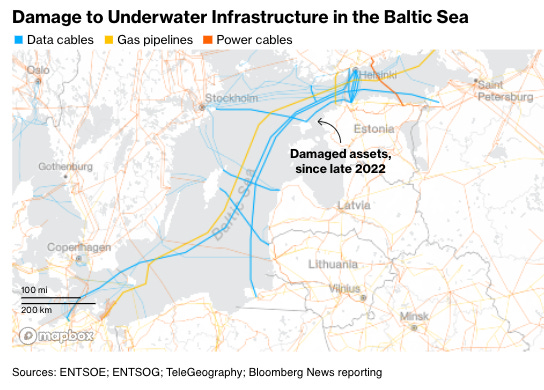Contents
Introduction
What Is Happening In The Baltic Sea?
Why Now?
Moving Forward
Concluding Remarks
Bitesize Edition
Conflict and war are hybrids in today's world. A cyber attack can occur while a debris field is created in the path of a geopolitical rival's satellite. Trade tariffs or the restriction of the trade of scarce resources can be implemented while an undersea cable is cut. Today, I will discuss the branch of conflict relating to infrastructure damage.
Since November, we have seen multiple occurences of infrastructure damage in the Baltic Sea. Sweden, Denmark, Finland, and the Baltics of Latvia, Lithuania, and Estonia are the key states involved. But due to their ports on the Baltic Sea, so are the Russians.
The Washington Post released an article a few weeks ago discussing one of these incidents of undersea cable damage as an accident. First of all, one example of an accident doesn’t automatically mean the others are. This means this topic is worth exploring.
Why is this happening at all? Why is it happening now, and how can this larger trend of infrastructure warfare even begin to be addressed? Let’s dive in.
Introduction
Over the last few months, infrastructure in the Baltic Sea has been sabotaged, with the main strategy being the severing of undersea cables. I’ve discussed many times how the infrastructure we so heavily rely on to function in our everyday lives is susceptible to sabotage by geopolitical rivals. Is this new form of conflict presenting itself in the Baltic Sea?
A few weeks ago, an article from the Washington Post stated that one such incident of cable damage was accidental. However, damage has occurred multiple times in the Baltic Sea. Can this truly be accidental every time, and who is involved here if it is sabotage? If this is purposeful sabotage, what could the reasoning be behind it, and where do we go from here? Let’s break it down.
What Is Happening In The Baltic Sea?
When it comes to this latest iteration of infrastructure damage as a geopolitical weapon, it’s debatable as to when it first started. Did it start with the cutting and theft of the Svalbard cable back in 2022, the fastest fibre optic cable in the world that still hasn’t been found? Or did it begin with the sabotage of the Nord Stream 2 pipeline later in the same year? A clear trend of infrastructure damage can’t be denied. Is this latest occurrence in the Baltics a continuation of these events?
Back in November, we had two submarine telecommunication cables, the BCS East-West Interlink, and the C-Lion1 fibre-optic cables disrupted. The BCS East-West connects Lithuania and Sweden at a depth of 100-150 metres, and the C-Lion1 for data communication between Finland and Germany was cut at a depth of 20-40 metres. The BCS East-West provided close to one-third of the internet capacity for Lithuania. Since November 19th, the Chinese cargo ship Yi Peng 3 has been suspected of the damage. The question is whether it was accidental or purposeful damage. Both cables were operating again by November 28th. Another development occurred a month later, when a Russian Navy rescue tug, Yevgeniy Churov, approached the anchored Yi Peng 3, and passed it at a slow speed with its transmitter turned off.

Another incident occurred on December 25th when a vessel named Eagle S departed the Russian port of Ust-Luga carrying unleaded gasoline, with a destination of Aliaga, Turkey. The vessel crossed the Estlink 2 submarine cable in the Gulf of Finland, and a power outage on the cable occurred at the same time. The vessel was ordered to enter Finnish territorial waters on December 26th, where it was bordered by Finnish police. The vessel was escorted to Porkkalanniemi where it was discovered to have a missing anchor. Drag lines were noted on the floor of the Gulf of Finland, and after a few weeks, the anchor was found by a Swedish Armed Forces vessel. The anchor had sustained damage and the vessel also had no insurance.
A third incident occurred on January 26th when a bulk carrier named Vezhen severed a submarine communication cable between Latvia and Sweden. The CEO of the company operating the vessel, Navibulgar from Bulgaria, expressed that the crew noted damage to the anchor on the same day. A few days later, a Swedish prosecutor confirmed this was an accident. A wave hit the anchor lock and released it, subsequently dragging it along the ocean floor as the vessel continued on autopilot.
A final incident occurred with Russian ships repairing an inoperable cable within Finnish territorial waters in the Gulf of Finland earlier this month. They were monitored heavily by the Finnish Coast Guard while they did this back in January.
These recent incidents join a collection of infrastructure warfare events that have unfolded over recent years in the Baltic Sea. One we suspect was accidental, but the others have multiple pieces of evidence of purposeful sabotage. The next question I’d like to explore, is why now?
Why Now?
One of Russia’s largest ports is in Saint Petersburg. To get to and from here, the Baltic Sea has to be navigated. This puts Russian vessels in the vicinity of the newest NATO members, Sweden and Finland. This especially raises tensions between the Finns and the Russians due to their interconnected history. Finland previously existed as a neutral state, and the Finnish change in stance prompted by the Russian invasion of Ukraine has led to tensions arising with Russia. Hence, are the latest moves in the Baltic Sea a battle for power and influence in an area that Russia seeks to be active in, especially if this comes at the expense of geopolitical rivals?
Keep reading with a 7-day free trial
Subscribe to Geopolitics Explained to keep reading this post and get 7 days of free access to the full post archives.



